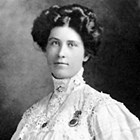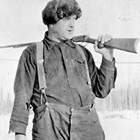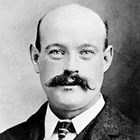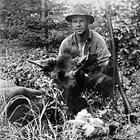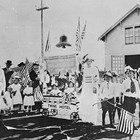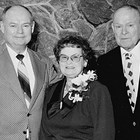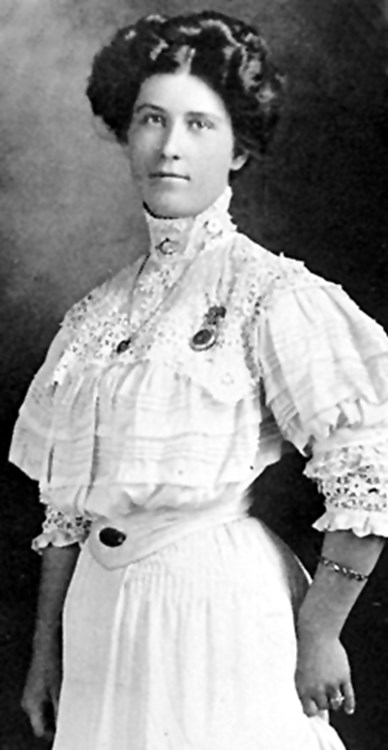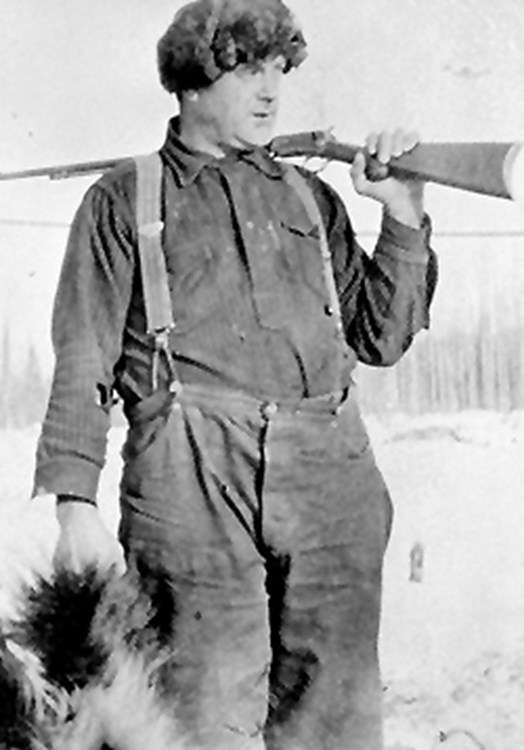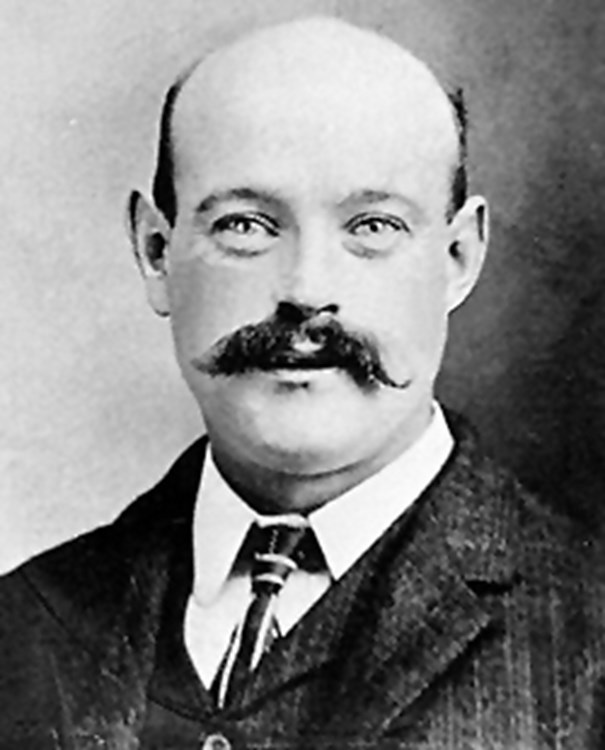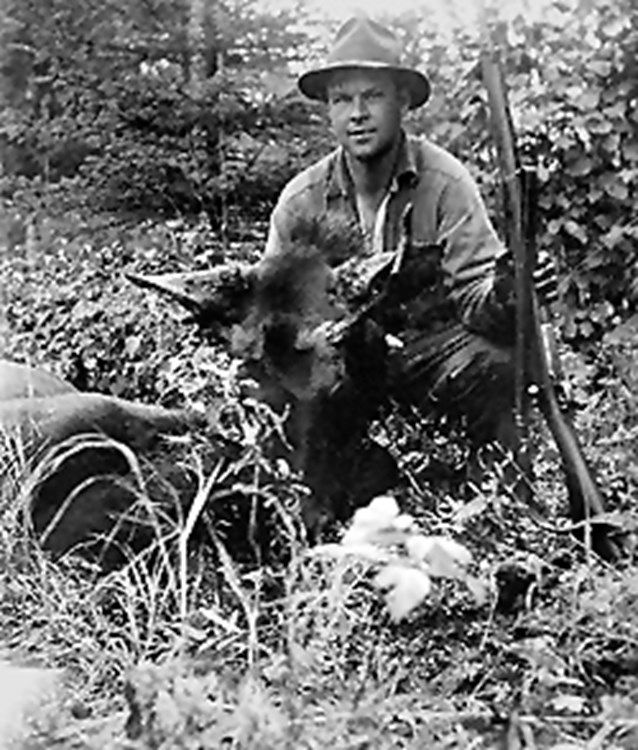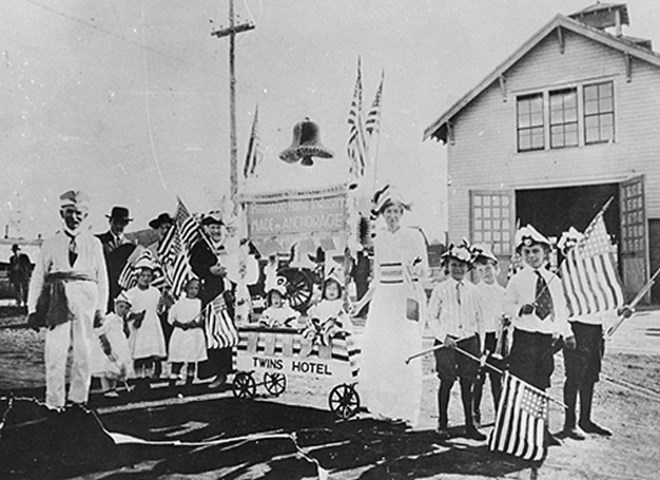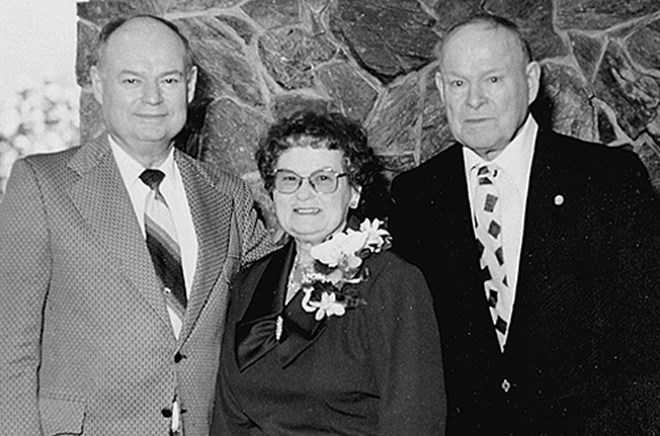Cavanaugh, Peter J.
1875-1940 | Miner and Alaska Railroad Employee
Peter J. Cavanaugh was born in Dubuque, Iowa in 1875. At the age of twenty-two, he joined the Klondike gold rush in 1898 and then went to Nome in 1899, where he met and married Agnes Jean Ross.
Agnes Jean Ross was born in Mount Pleasant, Pennsylvania in 1887, the daughter of Luther Ross and Marion Powell Ross. She had come to Nome in 1900 with her parents, who operated the Green Tree Hotel, a small hotel and grocery store in the town.[1] Peter and Agnes Cavanaugh were married in 1908, and moved south to the Pacific Northwest.
In the spring of 1915, the Cavanaughs again heard the call of the North, and this time it took them to Sunrise (near Hope) on Turnagain Arm at the time the first town lots were being laid out in Anchorage. Cavanaugh, a driller, did some work in the Crow Creek mining area before moving to Anchorage.
In 1915, the Cavanaughs arrived in Anchorage at a time when more than two thousand settlers were living at “Tent City,” the name given to the squatters' settlement of tents and temporary buildings that was formed at Ship Creek in March 1915. This temporary settlement was located mainly on the north side of the banks of Ship Creek, and was later described as a collection of “ragged, unsanitary tents, and temporary wooden buildings.”[2]
On April 10, 1915, a public announcement had been issued in Washington, D.C., by U.S. Secretary of the Interior Franklin K. Lane, that Anchorage at Ship Creek would be the field headquarters for construction of the Alaska Railroad. This announcement set off the largest land rush that had occurred at Ship Creek, with more than two thousand stampeders arriving in the area. The U.S. General Land Office, which had authority to dispose of the land around Ship Creek, quickly had the area that became Anchorage surveyed, cleared, platted and then auctioned off, and people moved off the flats so that construction on the Alaska Railroad could begin. In 1909, the landing at Ship Creek had been included within the boundaries of Chugach National Forest. The first auction of the original Anchorage townsite was held on July 10, 1915, with a frenzied crowd estimated from one thousand to three thousand in attendance, with 655 lots sold for approximately $150,000.[3]
Cavanaugh purchased a lot in the second town lot sale on the Anchorage townsite. The lot was located on Second Avenue, just east of C Street.[4] The family lived in a tent while Cavanaugh built a log cabin home, which was finished in March 1916. He worked as a construction foreman for the Alaskan Engineering Commission (AEC), the temporary federal agency in charge of building the Alaska Railroad. He worked with crews building the Eska, Gold Creek, Hurricane Gulch and Nenana bridges. After the Alaska Railroad was completed in 1923, he continued working for the railroad in the maintenance shop until 1936, when he retired with a pension of $109 monthly.[5]
After their retirement, the Cavanaughs moved to Washington State, where Peter Cavanaugh died in 1940. After her husband's death, Agnes Cavanaugh returned to Anchorage.
Peter and Agnes Cavanaugh had four children: James (born on November 7, 1909, in Nome); Emmett C. (born on March 9, 1911, in Nome); Catherine Cavanaugh Weimer (born on March 18, 1916, in Anchorage); Norman F. (born on November 28, 1923, in Anchorage).
Peter J. Cavanaugh died on April 18, 1940, at Providence Hospital in Seattle, Washington.[6] Agnes Jean Cavanaugh died on July 10, 1952, at her home in Anchorage after a sudden illness. She is buried in the Anchorage Memorial Park Cemetery.[7] She was survived by three sons, Emmett C. Cavanaugh (1911-1996)[8] and Norman Cavanaugh (1923-1993)[9] of Anchorage, and James Cavanaugh (1909-1992), of California; and a daughter, Catherine Cavanaugh Weimer (1916-2009),[10] of Anchorage; and eight grandchildren.[11]
Endnotes
[1] Entry for Mrs. Marion Ross, Proprietor, Green Tree Hotel, Nome, Alaska, 1905, in David A. Hales, Margaret N. Heath, and Gretchen L. Lake, An Index to Dawson City, Yukon Territory and Alaska Directory and Gazetteer, and Polk’s Alaska-Yukon Gazetteer and Business Directory, 1901-1912, Volume V, O-S (Fairbanks: Alaska and Polar Regions Department, Elmer E. Rasmuson Library, University of Alaska Anchorage, 1995-1999), 75, http:// https://scholarworks.alaska.edu/handle/11122/2730 (accessed November 19, 2016).
[2] Alfred Mongan, An Evaluation of “Anchorage Cultural Historic District: A Proposal” to Determine Eligibility for the National Register of Historic Places (Anchorage: Office of History and Archaeology, Division of Parks, Alaska Department of Natural Resources, 1974): Historical Background, item no. 8, page 8.
[3] Alfred Mongan, An Evaluation of “Anchorage Cultural Historic District: A Proposal” to Determine Eligibility for the National Register of Historic Places: Historical Background, item no. 8, pages 7-9; and Michael Carberry and Donna Lane, Patterns of the Past: An Inventory of Anchorage’s Historic Resources (Anchorage: Community Planning Department, Municipality of Anchorage, 1986): 6-7.
[4] Fond Memories of Anchorage Pioneers, Vol. 1 (Anchorage: Pioneers of Alaska, Igloo 15, Auxiliary 4, 1996), 37-38. No record of this land transaction could be found. On December 18, 1915, Peter Cavanaugh purchased a townsite lot located at Lot 10, Block 70, and he was issued a patent on January 21, 1922. See, Case Abstract AKA 00279j4, Pete Cavanaugh, Alaska Case Retrieval Enterprise System (ACRES) [database on-line], Bureau of Land Management, Alaska State Office, Anchorage, http://sdms.ak.blm.gov/acres/abstract/do_abstract_full (accessed November 19, 2016).
[5] John P. Bagoy, Legends & Legacies, Anchorage, 1910-1935 (Anchorage: Publications Consultants, 2001), 94-95; and Fond Memories of Anchorage Pioneers, Vol. 1 (Anchorage: Pioneers of Alaska, Igloo 15, Auxiliary 4, 1996), 37-38.
[6] “Early Day Railroader Passes Away,” Anchorage Daily Times, April 18, 1940, 1.
[7] Agnes J. Cavanaugh, U.S., Find a Grave Index, 1600s-Current [database on-line], http://ancestry.com (accessed November 19, 2016).
[8] Obituary, Emmett C. Cavanaugh, Anchorage Daily News, January 3, 1996, B-2.
[9] Obituary, Norman F. Cavanaugh, Anchorage Daily News, November 28, 1993, B-3.
[10] Obituary, Catherine M. Weimer, Anchorage Daily News, July 31, 2009, A-9.
[11] “Agnes Cavanagh, Pioneer, Dies,” Anchorage Daily Times, July 11, 1952, 13.
Sources
This biographical sketch of Peter Cavanaugh is based on an essay which appeared in John Bagoy's Legends & Legacies, Anchorage, 1910-1935 (Anchorage, AK: Publications Consultants, 2001), 94-95. See also the Peter Cavanaugh file in the Bagoy Family Pioneer Files (2004.11), Box 2, Atwood Resource Center, Anchorage Museum at Rasmuson Center, Anchorage, AK. Photographs courtesy of the Cavanaugh family. Note: edited, revised, and enlarged by Bruce Parham, November 19, 2016.
Preferred citation: Bruce Parham, “Cavanaugh, Peter J.,” Cook Inlet Historical Society, Legends & Legacies, Anchorage, 1910-1940, http://www.alaskahistory.org.
Major support for Legends & Legacies, Anchorage, 1910-1940, provided by: Anchorage Museum at Rasmuson Center, Atwood Foundation, Cook Inlet Historical Society, and the Rasmuson Foundation. This educational resource is provided by the Cook Inlet Historical Society, a 501 (c) (3) tax-exempt association. Contact us at the Cook Inlet Historical Society, by mail at Cook Inlet Historical Society, Anchorage Museum at Rasmuson Center, 625 C Street, Anchorage, AK 99501 or through the Cook Inlet Historical Society website, www.cookinlethistory.org.
